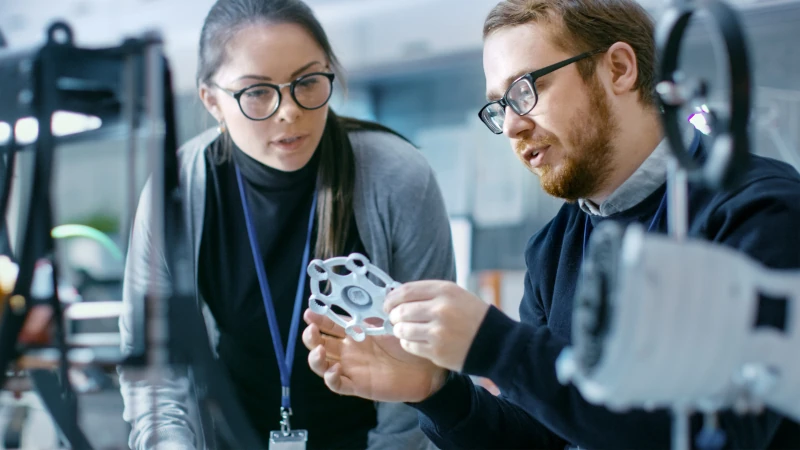
Additive Manufacturing for Mass Production: When is AM Most Efficient?
In the past decade, additive manufacturing (AM) has become increasingly popular among manufacturers due to its ability to create complex geometry, produce on-demand, and save on production costs, and more. However, similar to any other manufacturing method, there may be situations where AM isn't a good fit for your production.
Here, we explore when AM is the best fit for mass production and when traditional manufacturing methods are a better option.
What is Additive Manufacturing?
Additive manufacturing (also commonly known as 3D printing) is the process of manufacturing three-dimensional components from a CAD file or 3D scan, layer-by-layer, until the final desired shape is achieved. Unlike subtractive manufacturing, which cuts away excess material to create an object, AM adds material until the desired object is built.
Additive vs. Subtractive Manufacturing: How Does AM Compare to Traditional Methods of Mass Production?
Compared to traditional methods such as injection molding and die casting, additive manufacturing offers a number of advantages. For example, AM is more versatile in terms of the shapes and geometries that can be produced. Secondly, it’s generally faster and cheaper to produce prototypes and small batches of parts using additive manufacturing.
Considerations Regarding AM and Mass Production
Manufacturing isn’t a one-size-fits-all process. There are several factors to consider when deciding whether or not AM is the best option for mass production, including:
- Required Lead Times
- Part Complexity & Functionality
- Total Cost of Ownership (TCO)
1. Required Lead Times
A lead time is the time that elapses between the initiation of a process and the completion of that process. There are many factors that determine additive manufacturing lead times, such as the complexity of the model you’re manufacturing, what material you’re using, required material settings, and the technology you’re using (Direct Metal Laser Sintering, Binder Jetting, etc.).
With AM technology, you can go from a design concept to a printed prototype in hours to days - something that typically requires weeks or sometimes months to achieve with traditional manufacturing. Additionally, the AM process is software driven, so changing a design is as simple as editing the 3D image file. This speeds up the prototyping process and serves as a bridge to mass production, bringing your products to market faster.
Another thing to keep in mind when deciding whether AM is the right option for your mass production, is desired surface finish. Depending on the end use and need for tight tolerances, additively manufactured parts may need to undergo post-processing techniques, such as machining, threading, and polishing. This can also add to the overall production time and cost.
2. Part Complexity & Functionality
There’s no question additive manufacturing is capable of mass producing complex, lightweight parts. Did you know it can also help consolidate multiple assemblies into one component?
Additive manufacturing is an excellent option for those looking to reduce part count and assembly labor, along with adding improved performance. By using DFAM (Design for Additive Manufacturing), it’s possible to reduce part count and assembly labor, along with adding improved performance. This can be achieved in a number of ways, including producing lattice structures and topologically optimized structures for superior performance and light-weighting benefits.
3. Total Cost of Ownership
Finally, you need to evaluate the total cost of ownership (TCO). The upfront cost of an additive manufacturing system is often higher than a traditional system; however, the TCO of additive manufacturing is typically lower than traditional methods due to its waste reduction, shorter lead times, and increased flexibility.
Several factors affecting TCO are the purchase price of the AM machine, printing material, shipping, installation, and any attachments or accessories needed. If your company doesn’t have someone trained in designing for AM, additional training may be required in the original cost
Barriers to Adopting Additive Manufacturing
Despite the advantages it has to offer, some industries have been slow to adopt additive manufacturing technology. Common barriers to companies adopting DFAM include:
Technological Knowledge
DFAM is the process of optimizing your design to lower costs and make it faster and more effective for manufacturing. Different from traditional manufacturing, this design process empowers engineers to create more intricate shapes and production parts while reducing weight and material consumption.
Designing for AM requires knowledge of the following areas:
- Understanding of DFAM tools (software).
- Knowledge of AM technology and materials.
- Understanding of design problems and opportunities of AM.
The additional time and training for those not familiar with additives can be a deterrent for those wishing to enter the AM market. This is why working with a dedicated additive manufacturing company may be more cost efficient for those first starting out.
Limited Materials
Although new materials are being developed regularly, AM technology is still limited in compatible materials. Common materials used are metals, ceramics, polymers, and composites, along with smart materials, such as biomaterials and nanomaterials.
The Added Manufacturing Difference
Additive manufacturing offers a number of benefits for manufacturers looking to produce products in large quantities. It’s an efficient and economical manufacturing process that can quickly produce high-quality parts.
With the right equipment and knowledge, businesses can save time and money while expanding their product offerings with AM. If you are interested in exploring additive manufacturing as an option for your next project, visit our blog to learn all about AM.
